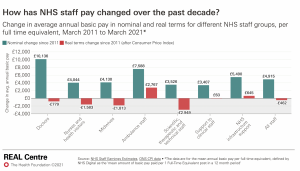As the ballot for nurses to take strike action nears to a close on 2 November, a poll of over 7,000 NHS nurses across the UK by NursingNotes, finds the vast majority are in favour of taking strike action.
There are huge regional variations, however, with Scotland at 76% support, the North of England 67%, London 56%, Wales 55%, and Northern Ireland 53%, whereas support in the South West is the lowest at 33%.
This is the first time in their history that the entire UK nurse workforce could go on strike.
Commenting on the strike ballot, UNISON general secretary Christina McAnea said: “Striking is the last thing dedicated health workers want to do. But with services in such a dire state, and staff struggling to deliver for patients with fewer colleagues than ever, many feel like the end of the road has been reached.
“The NHS is losing experienced staff at alarming rates. Health workers are leaving for work that pays better and doesn’t take such a toll on them and their families. If this continues, the health service will never conquer the backlog and treat the millions desperately awaiting care.
Patient safety
Many people are concerned about what a strike by nurses would look like and how patient safety is maintained. In reality, a strike by nurses will never be an all out strike, so that patient safety is protected, but it would lead to staffing levels more akin to a bank holiday or Christmas day.
As a letter from a nurse published in The Guardian noted,
“On strike days they’d ensure that there is cover for essential services and all critical care would go ahead as normal. And in actual fact, we’re working with unsafe numbers every single day. Striking is a means to end unsafe staffing practices.”
The number of staff and working patterns is negotiated with their employers before the strike begins.
Although a UK-wide strike of nurses has never taken place, there was a strike by nursing staff in Northern Ireland in December 2019. Here there were three models of derogations (an exemption provided to a member or service from taking part in industrial action).
- Complete derogation, with an entire service being exempt (for example, intensive care units)
- A Sunday service or Christmas Day service
- A night duty model, where the night duty numbers were agreed to cover the day duties (with requests for further staffing considered on a case-by-case basis).
In general terms the RCN state that industrial action must follow the life-preserving care model. This exempts:
- emergency intervention for the preservation of life or the prevention of permanent disability
- care required for therapeutic services without which life would be jeopardised or permanent disability would occur
- urgent diagnostic procedures and assessment required to obtain information on potentially life-threatening conditions or conditions that could potentially lead to permanent disability.
The Nursing and Midwifery council – the independent regulator confirm that nurses have the right to take industrial action and that the employer should seek to take steps to minimise disruption to the care of patients and people using services, but the individual professional duties on nurses remain the same.
How has the government reacted to the threat of a strike?
After years of inaction on the workforce pressures within the NHS, the recent post holders of Secretary of State for Health and Care appear to have done little to address the crisis. In an October interview with the Evening Standard the then Health & Care Secretary, Thérèse Coffey, said that nursing staff can leave the UK “if they want to” amid complaints over poor pay and short staffing.
She also said that the government could turn to overseas nurses to fill these gaps but refused to further improve pay.
Overseas recruitment, although a component of NHS recruitment for decades, is not an easy or cheap option. A case study for Hillingdon Hospitals’ NHS Foundation Trust found that it cost £8,477.80 to recruit 21 UK nurses, and £6,371.41 to hire just one nurse from overseas. If you multiply this by the number needed to fill the gaps, the scale of the cost of recruiting overseas to fill vacancies is phenomenal.
The comment by Coffey also implied that nurses from overseas would be content with poor pay and working conditions. Nurses recruited overseas are trained professionals, not cheap labour, as Patience Bamisaye, a nurse recruited from overseas, noted eloquently in an article in NursingNotes:
“It is incomprehensible to imagine that foreign-educated nurses would be content to put up with poor working conditions and unfair pay simply because they are coming from another country.”
With Stephen Barclay back at the DHSC, as of 26 October, it’s unclear what approach will be taken to the strike. HSJ reports that when he was briefly at the DHSC in July/August, health leaders reacted with dismay to his appointment, saying he viewed the NHS as a “bottomless pit, resistant to change and unaccountable”.
How successful can strikes by nurses be?
Strikes by nurses are rare but in December 2019 NHS nurses in Northern Ireland went on strike led by the now RCN president Pat Cullen.
Nurses in Northern Ireland were paid less than in the rest of the UK, but due to a long-term dispute between Sinn Fein and the DUP over the Cash for Ash scandal the Stormont administration was not working and there was no administration to negotiate a pay increase.
Nurses in Northern Ireland voted to strike. It began in December 2019 and by mid-January, Sinn Fein and the DUP had entered talks with the RCN, and by the end of the month, nurses had been given a £109m pay deal.
Why are nurses planning to strike?
The decision to call a strike is never an easy one, but the general secretary of the RCN, the UK’s largest nursing union, Pat Cullen, told the Observer in September that there is real anger among nurses.
The pay rise earlier in the year of £1,400, leaves nurses £1,000 a year worse off in real terms, and pay has not kept up with inflation over the past decade for many staff.

Cullen noted:
“We need to step up and look after these nurses. If we don’t, it’s scary to think about what will happen. The health service is not just staring over the precipice. It has gone over. And the very people who are trying to bring it back up are being paid the lowest wage we can possibly pay them. If we deplete it any further, there will not be a health service there.”
Although on the face of it the strike is over pay, the low levels of pay are linked to the escalating workforce crisis in the NHS and this ultimately impacts on patient safety.
Both the RCN and the union UNISON, which represents nurses and many of the lower-paid workers in the NHS, believe that not only is a proper pay rise needed to enable staff to survive the cost of living crisis, but without it the crisis in workforce numbers will escalate. The RCN wants a rise of 5% above inflation to avoid a flood of nurses leaving the profession.
UNISON head of health Sara Gorton said:
“The backlog won’t reduce, nor will waiting times and delays lessen unless the NHS can keep hold of its experienced employees and attract new people.
“A proper pay rise would help the NHS start tackling the growing staffing shortages hampering its ability to cut waiting lists and reduce ambulance delays.
“But disruption isn’t inevitable. Ministers could come up with a decent wage increase and a proper workforce plan. The ball is sitting in the government’s court.”
The NHS desperately needs more staff and for its current staff to stay. But staff are leaving the NHS at record levels, with 400 a week leaving according to a survey in February 2022. Nurses often move to work for nursing agencies, where pay is better. Lower paid staff move to work in different industries, where pay is better.
The latest statistics on vacancy rates from NHS Digital show a vacancy rate for registered nursing staff of 11.8% as at 30 June 2022 or 46,828 vacancies.
A lack of staff is having a major impact on patient safety.
In July 2022, the health and select committee within Parliament, which heard evidence from over 150 organisations, concluded that:
“The persistent understaffing of the NHS now poses a serious risk to staff and patient safety both for routine and emergency care. It also costs more as patients present later with more serious illness.”
The current situation was succinctly summed up in a letter from a nurse published in The Guardian:
“Although strikes would necessarily cause some disruption, this would be small beer compared with the ongoing day-to-day chiselling away at NHS services caused by austerity over the past 12 years. The 5% pay rise is completely inadequate. Real-term pay has dropped like a stone in the past decade. We cannot recruit. We cannot retain staff. And given the stratospheric rise in living costs, these problems will just be compounded over time.”
Dear Reader,
If you like our content please support our campaigning journalism to protect health care for all.
Our goal is to inform people, hold our politicians to account and help to build change through evidence based ideas.
Everyone should have access to comprehensive healthcare, but our NHS needs support. You can help us to continue to counter bad policy, battle neglect of the NHS and correct dangerous mis-infomation.
Supporters of the NHS are crucial in sustaining our health service and with your help we will be able to engage more people in securing its future.
Please donate to help support our campaigning NHS research and journalism.


